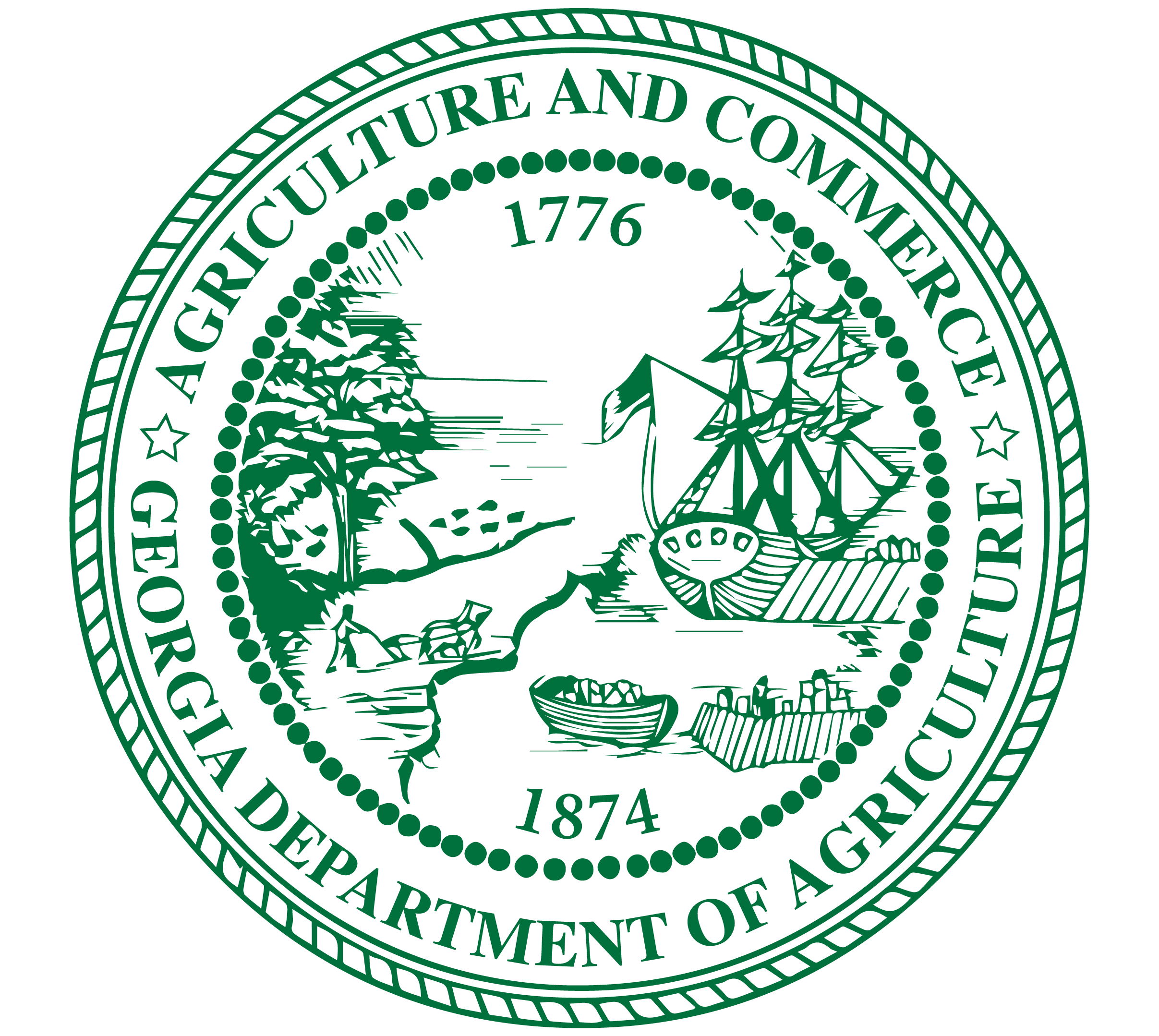This document is intended to be a “Guideline” which describes in simple terms a number of basic requirements which must be met before licensing food firms. For further assistance, contact the District Office in your area (listing below).
Licensing
Georgia Food Act (Section 26-2-25) “It shall be unlawful for any person to operate a food sales establishment without having first obtained a license from the Commissioner”
“Food Sales Establishment” means retail and wholesale grocery stores; retail seafood stores and places of business; food processing plants, except those food processing plants which are currently required to obtain a license from the Commissioner under any other provision of law; bakeries; confectioneries; fruit, nut, and vegetable stores or roadside stands; wholesale sandwich and salad manufacturers, including vending machines and operations connected therewith; and places of business and similar establishments, mobile or permanent, engaged in the sale of food primarily for consumption off the premises.
A license application signed by a corporate officer or a designee must be submitted to the Georgia Department of Agriculture.
A license may not be transferred from one person to another person, from one food establishment to another, or from one type of operation to another. The Department does not issue temporary permits.
Important: You must provide proof of citizenship or legal residency when you apply for a license. GDA requires S&V (Secure & Verifiable) documents for all licensees. See the S&V Details page and S&V FAQ for complete information.
There will be an annual fee for the license.
Additionally, a written business plan is required that details the functions of the business. Details are at the Food Establishment Business Plans page (also linked from our main Retailers page).
Inspection
Inspections shall be conducted as often as the Department deems necessary to ensure compliance with these regulations and at a minimum established by Departmental directives.
Certified Food Protection Manager Requirement
Firms that have Time/Temperature Control for Safety Food (TCS Food) and perform specific handling activities must have at least one employee that has supervisory & management responsibility that is a certified food protection manager (CFPM) by passing a test through an accredited program.
For additional guidance, reference the Guidance for Industry on the Certified Food Protection Manager Requirement document that can be found on our main Retailers page.
Facilities
Receive approval from proper zoning authority for land use and comply with all other governing agencies.
Building plans and supporting information shall be submitted to the Department when constructing a new establishment, conversion of an existing structure, remodeling or changing the type of establishment.
A private home, a room used as living or sleeping quarters, or an area directly opening into a room used as living or sleeping quarters may not be used for conducting food establishment operations. Living or sleeping quarters located on the premises of a food establishment shall be separated from rooms and areas used for food establishment operations by complete partitioning and solid self-closing doors. An exterior door must be included in the food establishment space.
Shared-Time/Community Kitchens are available in some areas for leasing kitchen space. For additional guidance, reference the Guidelines for Community Kitchens document that can be found on our main Retailers page.
Facility Requirements
Exterior Walls, Doors, Floors and Roof of a food establishment shall effectively protect the establishment from the weather and the entry of insects, rodents, and other animals.
Materials for indoor floor, wall, and ceiling surfaces under conditions of normal use shall be smooth, durable and easily cleanable for areas where food establishment operations are conducted.
Attachments to walls and ceilings such as light fixtures, mechanical room ventilation system components, vent covers, wall mounted fans, decorative items, and other attachments shall be easily cleanable.
Pest Control
Adequate measures shall be in place to preclude contamination by insects, rodents, and other pests: within the physical facility and its contents; and on the contiguous land or property.
Warewashing
A sink with at least 3 compartments used for manually washing, rinsing, and sanitizing equipment and utensils. Sink compartments shall be large enough to accommodate immersion of the largest equipment and utensils.
Equipment and utensils shall be stored in a self-draining position that allows air drying and covered or inverted.
Handwashing
Handwashing facilities shall be installed to permit the convenient use by all employees in food preparation and warewashing areas. Additionally, at least one handwash sink shall be located in, or immediately adjacent to, restrooms.
Each handwashing sink or group of adjacent handwashing sinks shall be provided with a supply of hand cleaning liquid, powder, or bar soap and individual disposable towels or air-drying device.
Service (Mop Sink)
At least 1 service sink or curbed cleaning facility equipped with a floor drain shall be provided and conveniently located for the cleaning of mops or similar wet floor cleaning tools and for the disposal of mop water & similar liquid waste.
Toilets and Urinals
At least 1 toilet, and not fewer than the number of toilets as may be required by other laws, shall be provided.
Water
Water shall be obtained from an approved public or private source and plumbed with hot and cold running water under pressure. The hand washing sink can accomplish the accurate temperature through a mixing valve or combination faucet. The water source and system shall be of sufficient capacity and pressure to meet the water demands including the peak hot water demands throughout the food establishment.
Plumbing
A plumbing system shall be designed, constructed, and installed according to local code. A plumbing system and hoses conveying water shall be constructed and repaired with approved materials.
Floor drains may be required under some conditions and shall be installed as regulations and local codes require. Areas that clean equipment in place, such as meat markets, shall be provided with drains and be graded to drain.
Sewage
Sewage shall be disposed through an approved public or individual disposal system (Onsite Sewage Management System). A letter from the local Environmental Health Department approving the system is required when a septic system is used.
County or municipal sewer system evaluation may be required to approve a grease trap, or to allow an exemption.
Outside Premises
The premises shall be free of excessive vegetative growth and debris.
The outdoor walking and driving areas shall be surfaced with materials that minimize dust, facilitate maintenance, prevent muddy conditions, and shall be graded to drain.
Exterior surfaces of establishment buildings and associated structures shall be of weather-resistant materials.
Outside Receptacles and waste handling units for refuse, recyclables, and returnables shall be designed and constructed to have tight-fitting lids, doors, or covers. These units shall be installed so that accumulation of debris and insect and rodent attraction and harborage are minimized and can be effective cleaned around and under.
Refrigeration
Equipment for cooling and heating food and holding hot and cold food shall be sufficient in number and capacity to provide proper food temperatures: a maximum of 41 degrees Fahrenheit for Cold Foods and a minimum of 135 degrees Fahrenheit for Hot Foods.
Approved Source
Food shall be of sound condition and safe for human consumption and shall be obtained from sources that comply with applicable laws relating to food safety.
Food prepared in a private home may not be used or offered for human consumption in a food sales establishment, neither shall rooms used to store or offer food for sale, be used as living quarters.
Labels
All product labels are subject to review by the Department. Basic label requirement for food products include:
- The common name of the product.
- The net contents in definite units (Refer to 40-15-3-.08)
- Liquid, in liquid measure; solid in terms of weight; and mixture (solid and Liquid) in terms of weight
- Must be listed on the label in the bottom 30 % of the principal display panel
- Include metric declaration. For example: Net Wt. 16 oz (454 g.); or 16 Fl. Oz. (473 ml.)
- A list of ingredients (further broken down to list their sub-ingredients), the common name of each ingredient and in order of predominance by weight.
- The name and address including the zip code of the manufacturer, packer or distributor.
- Nutrition labeling unless exempt
- Allergen declaration.
The FDA has a guidance document for food labeling, in multiple languages, which can be viewed and downloaded at: http://www.fda.gov/food/guidanceregulation/guidancedocumentsregulatoryinformation/labelingnutrition/ucm20068 28.htm
Variances
A variance is a modification or waiver of one or more requirements of the Regulations and must be submitted to the Department as a written document. The Department will review the variance to determine that a health hazard or nuisance will not result from the modification or waiver.
Additional Regulations
Additional regulations may apply based on the type(s) of food operations conducted at the establishment.


